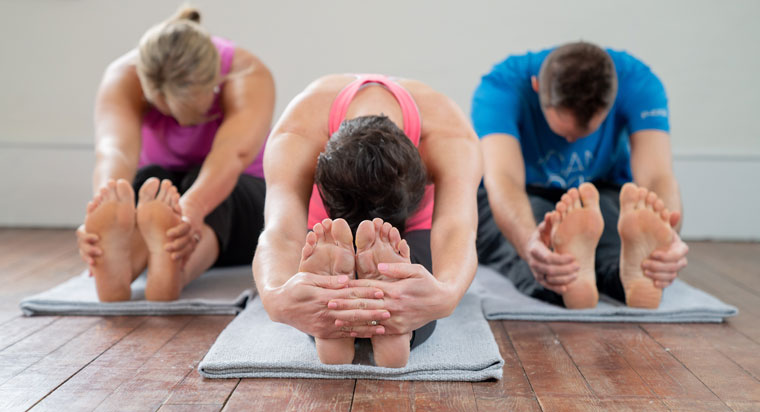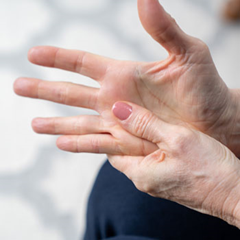Osteo Vs. Rheumatoid Arthritis: Their Many Differences

Answer a few questions and we'll provide you with a list of primary care providers that best fit your needs.
Both cause stiff, painful joints. Both are types of arthritis. Other than that, rheumatoid arthritis and osteoarthritis share little in common.
Their differences begin with what causes them. Osteoarthritis is more commonly occurs later in life, after years of mechanical wear and tear on the cartilage which lines and cushions your joints. Rheumatoid arthritis, which can occur at most any age, is an autoimmune disease. That is, your body's immune system attacks your joints.
Dr. Michael Raab explains the differences of osteoarthritis and rheumatoid arthritis.
Click play to watch the video or read video transcript.
Here are other important things to know about the key differences between osteoarthritis and rheumatoid arthritis.
Disease Onset
Osteoarthritis tends to develop gradually over several years, as the joint cartilage wears away. Eventually the bones of your joints rub against each other.
In contrast, the pain and stiffness of rheumatoid arthritis can develop and worsen over several weeks or a few months. In some cases, joint pain isn't the first sign of rheumatoid arthritis. It may also begin with "flu-like" symptoms, such as fatigue, fever, weakness, and minor joint aches.
How Many Are Affected
Osteoarthritis is the most common type of arthritis. It affects 27 million Americans. Rheumatoid arthritis (or RA) affects about one-tenth as many people.
In women, RA often begins between ages 30 and 60. With men, it often occurs later.
Joint Stiffness
 With osteoarthritis, mild joint stiffness is common in the morning and after an hour or more of inactivity during the day. As the joints start to be used and move more, even after just a few minutes, the stiffness and pain
improves.
With osteoarthritis, mild joint stiffness is common in the morning and after an hour or more of inactivity during the day. As the joints start to be used and move more, even after just a few minutes, the stiffness and pain
improves.
In contrast, it can take an hour or longer for the morning stiffness of rheumatoid arthritis to subside. In some cases, prolonged morning joint stiffness is the first symptom of rheumatoid arthritis.
Symptoms
Osteoarthritis symptoms include:
- Joint pain. This ranges from aching to burning sensations to sharp pain. Osteoarthritis primarily affects the knees, hips, spine, hands, and feet, but can arise in other joints, too.
- Stiffness in the morning. This goes away with movement.
- Muscle weakness around the affected joint. This is common for the knee joint.
- Deformed joints. Especially as arthritis worsens
- Reduced range of motion and loss of joint use. Occurs as arthritis severity progresses
- Cracking and creaking. Medically called “crepitus”
Rheumatoid arthritis symptoms include:
- Pain, stiffness, and swelling. Most commonly in the joints of the hands, feet, wrists, elbows, knees, and ankles
- Inflammation. If not managed, inflammation can lead to permanent, irreversible joint damage.
- Bumps or nodules. In some cases, these form over the elbows and knuckles.
Considered a systemic disease, rheumatoid arthritis affects the entire body and can affect both sides of the body at the same time. For example, while osteoarthritis may impact only the right or left knee, rheumatoid arthritis could simultaneously strike both knees.
In severe cases, rheumatoid arthritis may also affect the eyes, lungs, heart, nerves, or blood vessels. RA can raise your risk of heart disease 50 percent.
Diagnosis
Osteoarthritis diagnosis
While examining you to rule out other conditions, your doctor will ask you about your symptoms:
- How do you describe your pain? Burning, aching, or sharp?
- Do you have morning joint stiffness? If so, how long does the stiffness last?
- Do your joints swell?
Your doctor will examine you for joint tenderness and swelling, as well as muscle weakness, to help determine whether you have arthritis. Your doctor may also order X-rays to check for joint damage or blood tests to see if other conditions may be causing your pain.
Rheumatoid Arthritis diagnosis
Timely diagnosis of rheumatoid arthritis is important. Permanent joint damage can start within a year of having the disease.
Your doctor will conduct a physical exam to check your joints for signs of swelling or tenderness and will also ask about your symptoms and health history.
Your doctor may order blood tests, X-rays, and other tests.
Treatment
Osteoarthritis treatment
Treatment varies from one person to the next. Osteoarthritis is not reversible, but the symptoms can be managed. Your doctor will work with you to determine the best treatment for you:
- Pain medicine. Mild pain may be treated with over-the-counter pain medicines such as acetaminophen and nonsteroidal anti-inflammatory drugs (NSAIDs). If these don’t relieve your pain, your doctor may prescribe stronger medicine. Shots of medicine in the joint help some people.
- Heat or ice. Heat may help relax the muscles around the affected joint. Ice can relieve pain and swelling after activity or exercise. Your doctor may give you a gel or cream to help your joint pain.
- Weight loss, if you're overweight. Weight loss helps reduce stress on your joints. Every pound of body weight lost takes 3-5 pounds of pressure off the lower extremity joints.
- Exercise. Strengthening your muscles can reduce joint stress by offloading the joint itself. Movement is the best medicine for osteoarthritis. Talk with your doctor about the type of activity that’s best for you.
- Surgery. If other treatment methods do not lessen the pain in a joint, such as your hip or knee, your doctor may recommend having surgery to replace the joint.
Rheumatoid Arthritis treatment
Treatment includes medicine, exercise, and lifestyle changes, which must continue throughout life. Seeking treatment early can control the condition and prevent it from worsening.
Many RA medicines have side effects, so regular doctor checkups are important.
If your pain and joint function worsen after trying medicine, exercise, and lifestyle changes, your doctor may recommend surgery, such as total joint replacement of the hip or knee.
To improve your life with rheumatoid arthritis:
- Rest when tired.
- Use splints, canes, walkers, and devices. For instance, special kitchen gadgets or doorknobs to protect your joints.
- Eat a balanced diet.
- Exercise regularly.
- Maintain a healthy weight.
Answer a few questions and we'll provide you with a list of primary care providers that best fit your needs.
Source:






